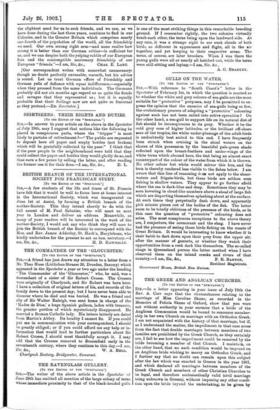GULLS ON THE WATER.
[TO THE EDITOR OF THE " SPECTATOR:1
SIR,—With reference to "South Coast's" letter in the Spectator of February 1st, in which the question is mooted as to whether the white and grey colours of sea-gulls are the most suitable for " protective " purposes, may I be permitted to ex- press the opinion that the enemies of sea-gulls being so few, the evolutionary process of adapting a " protective " colouring against such has not been called into active operation ? On the other hand, a sea-gull to support life on its natural diet of fish should be inconspicuous to its prey. Whether it be the cold grey seas of higher latitudes, or the brilliant off-shore seas of the tropics, the white under-plumage of the adult birds is undoubtedly best suited to this end. I have frequently been struck when cruising in the shoal waters on the shores of this possession by the beautiful pale-green shade reflected upon the breast-feathers and under-wings of the white terns which abound here, the tint being an almost exact counterpart of the colour of the water from which it is thrown. No other colour but white would mirror this hue, and the tern is thereby rendered less visible to the fishes below. I am aware that this line of reasoning do es not apply to the shear- waters and frigate-birds, but these birds are seldom seen fishing in shallow waters. They appear to go farther afield where the sea is dark-blue and deep. Sometimes they may be seen hovering in cloud-like numbers above a shoal of large fish which are disporting themselves splashing about at the surface. At such times they perpetually dash down, and apparently pick minute pieces out of the bodies of the fish. The latter seem to be totally oblivious of the presence of the birds, so in this case the question of " protective " colouring does not arise. The most conspicuous exceptions to the above theory are, I conjecture, the cormorant and the shag. I have never had the pleasure of seeing these birds fishing on the coasts of Great Britain. It would be interesting to know whether it is their habit to dart down upon their prey from the upper air, after the manner of gannets, or whether they watch their opportunities from a rock dark like themselves. The so-called shags in Queensland pursue the latter method when I have observed them on the inland creeks and rivers of that Resident Magistrate.
Government House, British New Guinea.






































 Previous page
Previous page